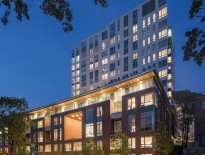
William Lyons
The list of transportation projects that could have a transformative impact on the Seaport District is very small. Most of the projects on the list are beyond the reach of our current funding environment, including and especially major expansions of our transit system. However, there is one project slowly making progress that will have a generational impact on the Seaport District – the rehabilitation of the Northern Avenue Bridge.
The Northern Avenue Bridge once served as the primary gateway to the extensive port facilities in existence on the waterfront from the time of the bridge’s construction in 1908 until its closure in 1997 (pedestrians could use the bridge until 2014). Unfortunately, the closure of the bridge occurred just as the Seaport District was evolving into its current day center of commercial activity. Since its closure, there has been a vast amount of speculation about what should happen to it.
Boston Mayor Marty Walsh has assembled a task force to elicit ideas about the future of the bridge and to decide its fate. Some have suggested a linear park with lush landscaping. Others have suggested a bike and pedestrian path. Still others have suggested that it be populated with shops and rechristened as a retail destination.
Predictably, many of the private sector interests in the Seaport District would like it reopened to traffic, since the district is severely underserved by transportation and the resulting congestion is choking growth.
But why do we need to choose? Why has this been made this out to be a binary choice? Can’t we have more than one function in this vital corridor, much as we have done for the rest of the Seaport’s transportation systems?
(sub) A Multi-Purpose Bridge
The Boston Globe editorialized on Aug. 13 that the Northern Avenue bridge should be repurposed into a linear park with bicycles and pedestrians, fashioned in the tradition of New York’s High Line. Others have also advocated for this approach, notably Boston Preservation Alliance. But can we really afford to decrease traffic capacity in the fastest growing neighborhood in the city? Especially since there are only a half-dozen viable ways into the district?
Early in the history of the bridge, there was a fire station located on it. It does not take much imagination to envision a new civic purpose on a new or refurbished bridge. Whether the ultimate use includes a city park or a retail destination (or both), it does not rule out the use of some portion of the bridge for transportation purposes. In fact, without a transportation purpose, it is hard to imagine investing $100 million of tax dollars into a structure that is principally for a park or for private interests.
I am fully engaged in the movement to reduce our carbon footprint and shift our travel patterns to more sustainable modes of transportation. I have advocated for more sustainable transportation systems within these pages and in industry forums across the country. But until we invest wisely in expansion of real transportation options, we cannot expect the employees, residents and shoppers who are traveling to the Seaport to arrive by any mode of travel other than an automobile. The admirable expansion of private transit options in the Seaport has made a small difference, but has only been achieved because the business community has invested in private shuttle systems as a means of last resort to get their employees to work and retain high quality human capital.
There is another way forward. The transportation use of the Northern Avenue Bridge could be limited to high capacity shuttle vehicles with a permit to cross the bridge. The volume of such vehicles would be considerably smaller than if it were open to the general public. Just as importantly, a dedicated bus lane on the Northern Avenue Bridge could have a very meaningful impact on congestion on the Moakley Bridge and throughout the Seaport. It is essential to the future of the Seaport that we not squander the opportunity to promote transit by making the Northern Avenue Bridge into a corridor for transit traffic.
It is not often that a project comes along with a potential $100 million impact on congestion. It may not happen again in the Seaport District in my lifetime. It is hard to imagine that the Northern Avenue Bridge would not continue to serve the transportation purpose for which it was originally constructed. But it just might.
(tag) William F. Lyons Jr. is president and CEO of the Fort Hill Cos.




 |
| 

